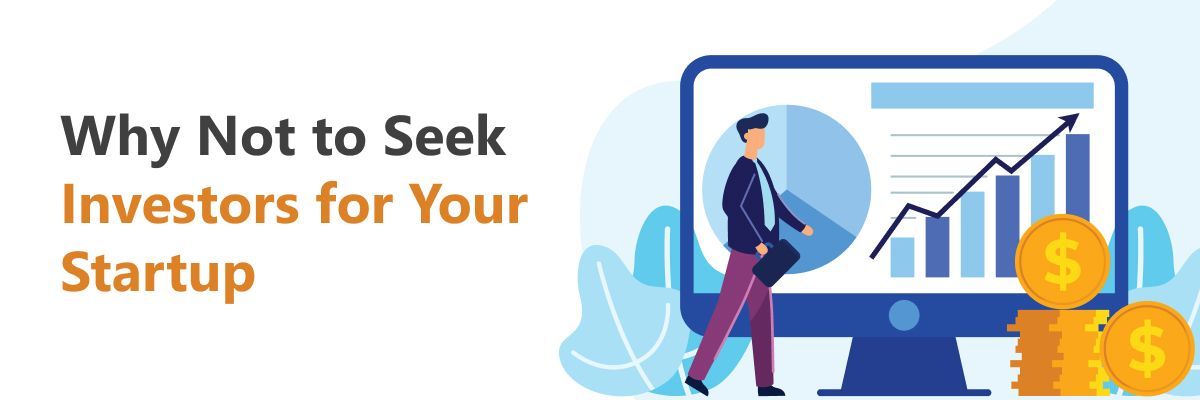Many founders often feel that raising investment for a startup is too hard and not worth the effort. Or they even think that there’s no other way to succeed as a startup founder without raising tons of funds.
Raising investment for any business isn’t that complicated, and there are various more accessible alternatives to startup investment.
Suppose you are a first-time founder who is at the early stage of building an inspiring startup full of potential. In that case, you will then be thinking of different ways to raise investment and might be even looking for some investment alternatives.
But the truth is:
-
-
- You won’t be able to achieve investment without fulfilling the minimum requirements needed before approaching any investor.
- Startups don’t always have to depend entirely on VCs or angels for funding; this means there are many other healthy alternatives to investment.
-
In this guide on “startup funding and investment”, we will walk you through many techniques regarding funding and raising startup capital. You can learn and implement those techniques for your business.
Many startups fail not because their product is terrible, instead, their decisions in finding investors or investments were poor. I know many startup founders looking to raise their first round of investment from angels, crowdfunding, institutional or corporate investors, or even venture capitals.
But I am sorry to say this: there is no hope for your business if you are not ready to understand the investor’s mindset, learn the right way to approach the funding process, and the right way to communicate with the investors to maximize your chances of success.
Investment isn’t that complicated. Most people who run a startup have a limited understanding of funding, and you often only need to get the basics right to succeed.
With this guide, you’ll learn the six essential areas to startup investment:
-
-
- How to know whether the investment is right for you?
- Different types of Investors: VCs vs. Angel investors
- How to find the right investor for your startup?
- Minimum Requirements before approaching an Investor
- Impact of taking on investment
- Alternatives to Investment
-
Here in this guide, I’ve created a fictional company called “HungryPanda” to use concrete examples for the complicated topics related to the startup investment and other funding processes. The HungryPanda example will help you understand the concepts easily.
HungryPanda is a food delivery service that has a unique USP. The drivers are dressed in fancy dress or a mascot of customers’ choosing (usually a panda) when they deliver meals. Also, note that this company is entirely fictional, and any resemblance to a real company is entirely accidental.
So with that said, let’s jump to the guide right away:
Is Funding Right for Your Startup?

So let’s clarify; when we talk about investment, what exactly does it mean?
Investment is when somebody gives you some cash in return for your business’s shares; that means they are buying a portion of your business. And this same action is also called equity investment.
So what types of businesses are suitable for investment?
Businesses that have been the most successful at raising investment are those that can overgrow into a size big enough to satisfy investors’ appetites. Usually, investing in a business at an early stage would be of high risk.
For the same reason, investors want to invest in companies full of potential. They usually expect a 5 to 10 times return on their investment and want to exit the investment within 5 to 10 years. So the investments are suitable for only businesses that can overgrow to a huge size.
When you are trying to assess whether you want to raise investment, you have to think about spending that money. It’s not enough to raise money and then fund your cash flow. It would be best if you thought about how you will use the funds to grow your business.
Always remember, the investor is investing to get a return, so you will have to boost the business’s value in such a way that the portion of your business they own also grows in value.
Here are the three actions a founder must focus on when they raise their first round of investment for a business:
1. Develop the Product
Let’s see how this works for our fictional company HungryPanda. Here we might have an online platform that works great. But we can use the investment to develop an app, as our community wants to order their food via an app.
2. Marketing
The second thing here is that we need to invest in raising our marketing. We need to invest in a big marketing budget to do a Facebook campaign or invest in somebody who could do Marketing full time.
3. Increase in Sales
An increase in sales is the final thing to focus on. Remember, if your business’s revenue grows, it increases your business’s value. So we must invest in bringing on board a great sales rep who can go and reach out to restaurants and get them onto the platform.
Once you have decided whether to raise investment for your startup, the next step is to find the right investors to fund your business.
How to Find the Right Investors to Fund your Startup
When you meet an investor and go through an investment round, you’re looking for a long-term relationship with him/her. You have to look forward to the next five or even ten years working with this organisation. So you need to make sure that they are the right fit for you. And the right fit for you is all about having the same mission and the same goals and the same vision for the business.
Before talking about finding the right investors for your business, let’s first discuss the different kinds of investors.
Different types of Investors: Angel Investors vs Venture Capitalist

Investors come in all different shapes and sizes. But if you’re looking to raise one of your first rounds of equity investment, then there are a couple of things that you need to know.
The two main types of investors that are relevant to you are Angel Investors and Venture Capital.
Angel investors usually are friendly. They typically want to help and to get involved by sharing their knowledge and experience with you. They usually won’t invest more than one million, not in the first few times of their support.
Angel investors typically expect 5 to 10 times return on their investment, and they’ll want to see that return within the next 5 to 10 years at a maximum.
However, Venture capital or VC funding is different. It’s a type of private equity, a form of financing where venture capital firms provide funds to startup companies showing high growth potential. VCs typically invest at a later stage, and they invest at least two to five million at the entry point. However, VCs do expect to have significant control of the business.
VCs will get very involved, and they’re very commercial. So they make decisions based on what is best for the business and its potential growth in the future. They seldom do care about what is right for the founder or the team.
Venture Capitalists will expect at least ten times a return on their investment, and they anticipate to see that return within five to eight years at a maximum. Typically, VCs invest in one out of 100 deals they consider, whereas angels invest in every ten out of 100.
If you are thinking of raising funds from venture capital, do bear in mind that they can take significantly longer, and you have to take account of that into your investment timeline.
Finding Right Investors for your Startup

Since all the investors know about the 90-10 rule (that 90% of startups fail and only 10% succeed), they aren’t always ready to take another risk by funding any startup. For the investors to support your business, you need to have a fantastic deal in your pocket that is unique within your industry.
Don’t forget to do your homework on investors before approaching them with that brilliant idea of yours. When we talk about doing your homework on an investor, we mean that you do some audit on them like they’re going to do on you before investing in you. Find out whom they have invested in the past, what stage was that startup when they supported it, and how much money they have funded.
Look at all these things and work out whether it makes sense for you. You need someone to invest in you who has got enough experience in your industry, and that will help you when you need some strategic advice.
One of the things we highly recommend is asking the potential investor whether you can have a conversation with another startup or the founder of another startup that they’ve invested in. And this way, you could get so many insights like:
-
-
- What is that investor like to work with?
- What are the processes that the startups have gone through?
- How do investors want to work with?
- Are they overbearing, or are they unfriendly?
-
Answer the above questions and it will give you an idea of whether or not to build a long-lasting relationship with that particular investor.
Another thing to remember is that you don’t have to focus on the amount of money that the investor will invest in you. We know capital is substantial, but note that it is more than just the money you have to see in an investor.
You have to look for a strategic partner for your business. The skills, experience, and strategic involvement of your company’s investors also count as their investment. So you have to look for an investor who has got a network that you can tap into. Also, look for an investor with some excellent experience within your sector, and hopefully, they can open doors for you that you couldn’t even imagine knocking on.
Finally, there are two more things to think about when you search for the right fit for an investor for you. And you must do these two things before you close a deal with them because we often see that startups do these after the investment has come in.
-
-
- Make sure that you’ve got the same exit plan as the investor. So what does this mean? You have to be sure about your business goals and have a concrete plan on how you will deliver that investor their return.
- Another scenario that may trouble you is that some investors look forward to selling your company in five years and might want multiple returns, often their investment. Whereas you, as the founder, may wish to work in the business for the next ten years, and you’re hoping to buy them out at the end.
-
Thus it’s vital to make sure that those visions are aligned before you close the deal with the investors.
Also, understand how they like to work with startups once they invest. Often, founders look for an investor who is very involved with the business by attending weekly or monthly meetings. In reality, they get an investor who is a little bit more silent and standoffish.
So make sure that these two things match up before you close the deal.
Do you know Why Startups Fail?
Minimum Requirements Before Raising Investment

Investors usually get hundreds of deals every month, but are moved only by very few. Thus it would be best if you help your startup stand out from the crowd.
These are five things that we recommend you to have in place before you go out and talk to investors because it will help increase your chances of success.
1. Showcase your Product through MVP
Minimum Viable Product or an MVP is the cheapest and basic version of your product that you can create and deliver. And the reason for this is that you don’t have to spend a lot of cash to develop a complete product and get it out to the public. With an MVP, you can get a sample or a prototype of your product to prove to investors that you can do things quickly and start to gain some precious feedback from early customers.
An MVP also allows you to see what customers want and get their feedback. Hopefully, you can get your first few customers who pays, which gives investors confidence in your product.
So here’s an example explained with our HungryPanda food delivery app. Here, our long term goal is to build an app for faster food delivery in fancy dress. But it can cost a lot of money, time and effort.
Instead, we need to get a prototype out there (in this case, a food delivery website will suffice) and test it to see if anyone is interested in it. Although this MVP isn’t scalable, it will at least give us an idea of whether anyone is interested in fast food delivery in fancy dress.
Check out Why Should You Create a Prototype for Your Startup Idea?
2. Investors Love to see a Credible Team in Action
The second thing you need to have is a credible team because investors don’t have much else to rely upon at the early stages. So it would help if you build their confidence in the team that you’ve around you.
It would be best if you spent time to define how that team is credible and their credentials and must also focus on their skills and expertise relevant to your business.
The other thing to remember is that investors often don’t like to invest in sole founders at the early stages because it’s a lot riskier to invest in one person. What if that founder decided they didn’t want to do it anymore or something happened, and they were no longer able to run the business. So investors only like to invest in a team of two or more people.
So if you are a sole founder, consider bringing on board a co-founder, somebody who has complementary skills essential to build the business you want to develop.
Also check out How To Find a Technical Co-founder or Technology Partner For your Startup?
3. Viable Business Model to Predict the Sales Flow
Another requirement is a viable business model, and this is entirely about demonstrating to investors that your product or your service can make money. So a business model is shown generally in an Excel spreadsheet because it’s a lot of numbers. And what investors look for here is that you understand what it costs to run your business, the sales and the revenue you’re going to generate and at what point you break-even. Break-even is when your sales become more or cover the costs of your running costs.
Remember, when you’ve got the business model, you need to demonstrate to investors how you will scale and grow the business. You have to define this from how you are going to sell from 10 units to 100 units and scale it up to a 1000 units, and so on. At the same time you have to keep the cost of selling low while your sales grow.
But it is good to know how to scale your startup.
4. Product-Market Fit – How your Product will Satisfy the Market Needs
The product-market fit is famously defined as being in a good market with a product that can satisfy that market. In other words, it is that beautiful moment where your product starts to sell itself or your customers start to sell it for you because it answers a real need and in the right market.
Achieving a product-market fit can take years; sometimes, it can take upto two years or more. So you have to look for early signs that you understand your customers and they are responding well to your product.
Remember, everybody thinks they have a great product, but one valid proof is customers. You are not your customer, so don’t second guess what they want; instead, go out there and find out.
5. Strong Plan for Growth
Another requirement for raising investment is showing that you’ve got a strong plan for growth, and this is something investors are going to look for. A strong strategy for growth is about telling the investor what your plans are for the next five years. And being clear about what the stepping stones are to get you there.
So when you’re talking about those stepping stones, you must also think about what it’s going to cost to hit each of those milestones. What this does is, it shows the investor that you have got an excellent growth plan.
It’s a lot easier said than done to have these five requirements under your belt, especially in the early stages of founding a business. So what we recommend is to try to get at least three of these down and then have a solid plan about how you’re going to hit the next two soon.
Suggested Read: How to Develop a Growth Strategy for Your Startup Business.
Impacts of Equity-Based Investment – Why Not to Seek Investors for Your Startup

Now there are also some downsides of getting investors for funding your business. We need to be realistic here. If you’re taking on equity investment, you should be ambitious about your growth plans and your targets for sales.
Grow the business and its value; this is what investors want, right?
For example, say if you were looking for a lifestyle business where you would want to go on holidays three times a year, if this is the case, then equity investment won’t be right for you.
So it’s essential to confirm whether you are in the right field that’s okay to seek investment from investors.
If that’s clear to you, then let’s talk about other impacts of taking on equity investment:
1. Take Risks
Of course, as a startup founder you have to take some risks. Because nine out of 10 startups fail, and investors know this. So it’s a high-risk investment for them, and in return, they’re going to expect you to take risks as well. And those kinds of risks are the ones that help you grow the business.
So considering that, know that you need to increase your sales and the number of customers.
Read our blog on How to Acquire the First 20 Customers for Your Startup.
2. Update them Regularly
Another impact of taking on investment is that you will have to keep your investors updated regularly. It would help if you decide with your investor what that regularly is; is it going to be monthly, quarterly or weekly? How do you want to meet with them? in person? Or via a virtual platform? Either way, you are going to have to keep them updated.
Investors need updates on everything about your business, and the reason why is simply because they’ve invested in your business. They want to see you become a success, and the chances are they’re going to have a lot of knowledge about your market, or they’re going to have a lot of network and contacts within your market. And most of the time they’ll be able to help you with problems. So do always keep your investor in the loop of any issues or any changes within your business.
3. Loss of Control
Another impact of taking on investment is that you’re going to lose a little bit of control. So remember, when someone buys a portion of your business, they’re getting shares in your business. As a shareholder in a business, you have the right to vote on big decisions within the company.
For example, if as a shareholder you own 10% or more, it could also mean that you have a right to sit on the board. When you sit on the board of a company, it means that you can have more influence over the day to day decision making. Such day to day decision making could also be who you hire and who you fire. So be aware that you are going to lose a little bit of control.
Alternatives to Raising Investment for your Startup

Indeed, raising investment is a tough decision to make and by now you may have understood that raising investment is not for everyone. Surely you are going to get lots of benefits through investing and there will be downsides that you have to face too, like the share of control.
However, before you raise investment, you might want to think about what the alternatives are out there and whether those could be right for you. If in case the alternatives work for you better, then you won’t have to worry about sharing your business control or decisions with others.
So here are six alternatives for you to consider:
1. Self-funded business model
Here you will be using the profits that your business had generated, and you put them back into the business to aid your growth. Self-funded business model is a slower way of growing your company, since the capital is very low, it takes time for any self-funded startup to break-even.
But if it’s more of a lifestyle business that you are working on, then this could be perfect for you. Because lifestyle businesses usually don’t require much of initial investment as you are making a living out of your passion.
2.Loans
Traditionally, startups haven’t been seen favourably for loans, but things change a lot. There are various loan providers out there, but you have to look for something that the local government funds. You can also talk to your bank to see what facilities are available with them.
The one thing to remember with loans is, some of these can be personally secured. Which means they will guarantee your assets against the loan. So there’s always a risk involved with loans and always take advice before going down this road.
3. Grant Funding
Grant Funding is great, but never see it as a free pot of cash. There’s always a return on investment needed when you are given a grant. One thing to remember with grants is that many grants require you to spend the cash upfront, and then you claim it back afterwards.
And also, we recommend you to find a grant that fits you. Don’t blindly accept a grant as you see it as some free money that can be invested in your business. Grants are not given out by organisations without checking if their motive and the business’s motives align. So make sure that the grant is genuinely aligned with what your business is doing.
4. Crowdfunding
Crowdfunding has raised in popularity over the last few years. There are two types of crowdfunding; There’s equity-based crowdfunding, and there is rewards-based crowdfunding. It’s basically where you leverage the power of the crowd to get investment into your business.
Equity-based crowdfunding is where the crowd will invest in your business to return a small slice of equity. Reward-based crowdfunding is where the crowd funds the company in return for a reward, so you don’t give away any equity, but you do give them the first version of your product when it’s released or an early version of the app, for example.
One thing to remember with crowdfunding is that the platform you use doesn’t do the job for you; instead, you also need to put some effort into it. So it is all about you pulling together your community and your network to build a brilliant marketing campaign to launch your crowdfunding. Some of the popular crowdfunding platforms are platforms like Indiegogo crowd cube shadow founder and Kickstarter.
5. Peer to Peer Lending
Peer to peer lending is a loan, and it’s not an investment. It’s also known as crowdlending. And this is often where the crowd can lend at better rates than if they’d put their money in a bank to save. And also that the rates for you as a startup will be more interesting too. One of the examples of a peer to peer lending site is Funding Circle.
6. Friends and Family
So over 40% of startups have reported borrowing from friends and family in the early days. So this is a great option to get you started. But one of the things that we ask you to do when borrowing money from friends and family is that you keep it professional. Make sure that you document it professionally. And this is for two reasons:
-
-
- If you go out for professional investment later down the line, investors will want to see that you’ve wrapped things up tightly.
- And secondly, it will avoid any family disputes later down the line.
-
Final Thoughts
Getting investors for your business can be a little complicated and riskier at the same time, but it is still by far the most effective way to raise investment real quick.
However, as mentioned earlier, you have to transform yourself to the high standards and fill in your pockets with all the minimum requirements you will be needing before approaching any investors.
But, like many, if you too feel you are not yet ready to get investment from investors, you can always try out the alternatives of investment that work well for many startups out there.
In short, to achieve success in raising fund for your startup, remember to follow the five steps of:
-
-
- Validate your Startup
- Create a list of target investors
- Perform Audit to short-list rights investors for your startup
- Fulfil the investment criteria
- Approach investors with potential numbers in your hand
-
Over time this process will help you build up your reputation and you will feel confident in approaching any investors.
I hope this guide helped you realise many aspects of raising funds for your startup and most importantly why investment can be optional for any startup business. Don’t worry if you’ve already made some investment decisions in the past that might not have been the perfect choices. Go through the above steps again and again before you approach the next investor for your business.
And who knows – next one will be the right investor that you might be shaking hands with.





